Investigating the Mutual Feedback between Wind–Sand Fields and a Running Train on the Bridge–Road Transition Section of a Railway
Abstract
:1. Introduction
2. Numerical Simulation Method
2.1. Mathematical Model
2.2. Sliding Mesh Method
2.3. Wind Speed Profile and Sand Volume Fraction
2.4. Simulation Parameters
2.5. Verification of Numerical Simulation Results
3. Model and Calculation Domain
3.1. Train and Bridge–Road Transition Section Model
3.2. Computational Domain and Boundary Conditions
3.3. Grid Division
4. Results and Discussion
4.1. Variation Characteristics of Wind–Sand Flow Velocity around Different Lines
4.2. Pressure Distribution around and on the Surfaces of High-Speed Trains
4.3. Pressure Variation of Measuring Points on the Surface of the High-Speed Train
4.4. Aerodynamic Load Variation of the High-Speed Train
4.5. Variations in the Aerodynamic Lateral Force Differences of the High-Speed Train
5. Conclusions
- (1)
- As the train drives from the bridge to the embankment, the pressure values on the windward and leeward sides of the train change abruptly, with the head train exhibiting the largest change. Moreover, the sudden change in pressure on the train increases with the transverse wind–sand flow speed. As the cross-section structures of the bridge and embankment are different, the transverse wind–sand flow produces different subgrade flows around different lines. The embankment slope blocks the incoming flow near the ground, which enhances the speed of the air flow on the windward side of the embankment, and thus the body pressure on the windward side increases rapidly. Moreover, on the leeward side of the train, the generation, development, and shedding of a large number of vortices rapidly reduce the pressure, resulting in a sharp increase in the lateral force of the train. When the train runs on the bridge, the transverse air flow can pass above the bridge floor and between the piers, and the transverse flow will not be blocked and accelerated. Therefore, the train will suffer less transverse force under the same wind–sand flow speed compared to running on the embankment.
- (2)
- The differential pressure force of the train running on the embankment is greater than that on the bridge, and the pressure differential force on both sides of the train is the largest. When the train runs in the reverse direction, the pressure differential force on both sides of the train gradually decreases, and the direction of the pressure differential force at the front of the head, middle, and tail trains is exactly the opposite to that of the driver’s cab at the tail train. In the wind–sand environment, when the high-speed train passes through the transition section between the bridge and embankment, the pressure difference between the two sides of the body obviously increases, and the surface pressure change at the front of the train is the most evident. This indicates that the front experiences the largest lateral force, and the risk of overturning is higher here compared to the middle and rear of the train.
- (3)
- When the train is running in the bridge–embankment transition section, the lateral force on the train will suddenly increase. Under the wind–sand condition, the lateral force on different positions of the train will increase compared with the non-sand condition. The average increase of the train body is approximately 17.6% (10 m/s), 10.5% (20 m/s), and 9.5% (30 m/s), respectively. This will cause passengers to feel the “shaking” of the train.
- (4)
- The lateral force difference of the train increases with the wind speed, and the lateral force difference of the head train at the 10 m transition section is the largest. The lateral force difference of the train under the wind–sand condition is higher than that under the non-sand condition. In addition, the influence of the wind–sand flow on the train running in the 5-m-high transition section is greater than that in the 10-m-high transition section.
- (5)
- Based on to the research results of this paper, future work will explore the following points. (1) Due to the “sudden change” in the aerodynamic transverse force of the train in the transition section between the bridge and embankment under the wind–sand environment, appropriate wind walls can be set up in the transition section in the wind–sand area to reduce the direct impact of the wind–sand flow on the high-speed train. The walls can also block the accumulation of sand particles on the track, effectively reducing the economic costs of manual sand clearing on the track. (2) In view of the “sudden change” in the aerodynamic lateral force of the train, the running speed of the train in the transition section can also be further optimized, the amplitude of the swing can be effectively reduced, and the smoothness of the train running in the bridge–embankment transition section can be improved.
Author Contributions
Funding
Institutional Review Board Statement
Informed Consent Statement
Data Availability Statement
Conflicts of Interest
References
- Zhang, K.; Qu, J.; An, Z. Characteristics of wind-blown sand and near-surface wind regime in the Tengger Desert, China. Aeolian Res. 2012, 6, 83–88. [Google Scholar] [CrossRef]
- Lei, J.; Wang, X.; Wang, D.; Zhou, C.; Xia, X. The blown sand disaster to the Tarim Desert Highway in Xinjiang, China. Sci. China Ser. D Earth Sci. 2002, 45, 165–173. [Google Scholar] [CrossRef]
- Chen, B.; Cheng, J.; Xin, L.; Wang, R. Effectiveness of hole plate-type sand barriers in reducing aeolian sediment flux: Evaluation of effect of hole size. Aeolian Res. 2019, 38, 1–12. [Google Scholar] [CrossRef]
- Bitog, J.; Lee, I.-B.; Shin, M.-H.; Hong, S.-W.; Hwang, H.-S.; Seo, I.-H.; Yoo, J.-I.; Kwon, K.-S.; Kim, Y.-H.; Han, J.-W. Numerical simulation of an array of fences in Saemangeum reclaimed land. Atmos. Environ. 2009, 43, 4612–4621. [Google Scholar] [CrossRef]
- Cheng, J.-J.; Xue, C.-X. The sand-damage–prevention engineering system for the railway in the desert region of the Qinghai-Tibet plateau. J. Wind. Eng. Ind. Aerodyn. 2014, 125, 30–37. [Google Scholar] [CrossRef]
- Zhang, X.; Xie, S.; Pang, Y. Numerical simulation on wind-sand flow field around railway embankment with different wind angles. Front. Environ. Sci. 2023, 10, 1073257. [Google Scholar] [CrossRef]
- Xie, S.; Zhang, X.; Pang, Y. Wind Dynamic Characteristics and Wind Tunnel Simulation of Subgrade Sand Hazard in the Shannan Wide Valley of the Sichuan–Tibet Railway. Int. J. Environ. Res. Public Health 2022, 19, 8341. [Google Scholar] [CrossRef] [PubMed]
- Hu, G.; Dong, Z.; Zhang, Z.; Yang, L.; Hao, L.; Hesp, P.; da Silva, G.M. Wind regime and aeolian landforms on the eastern shore of Qinghai Lake, Northeastern Tibetan Plateau, China. J. Arid. Environ. 2021, 188, 104451. [Google Scholar] [CrossRef]
- Wang, T.; Qu, J.; Niu, Q. Comparative study of the shelter efficacy of straw checkerboard barriers and rocky checkerboard barriers in a wind tunnel. Aeolian Res. 2020, 43, 100575. [Google Scholar] [CrossRef]
- Vercauteren, K.C.; Lavelle, M.J.; Hygnstrom, S. From the field: Fences and deer damage management: A review of designs and efficacy. Wildl. Soc. Bull. 2006, 34, 191–200. [Google Scholar] [CrossRef]
- Suzuki, M.; Tanemoto, K.; Maeda, T. Aerodynamic characteristics of train/vehicles under cross winds. J. Wind. Eng. Ind. Aerodyn. 2003, 91, 209–218. [Google Scholar] [CrossRef]
- Mei, Y.G.; Xu, J.L.; Zhao, H.Q.; Shen, Y. A research on numerical method of air flow around the high-speed train under crosswind. Eng. Mech. 2012, 29, 253–258+278. [Google Scholar]
- Wang, Z.; Li, T.; Zhang, J.Y. Research on aerodynamic performance of high-speed train subjected to different types of crosswind. J. Mech. Eng. 2018, 54, 203–211. [Google Scholar] [CrossRef]
- Xiong, H.B.; Yu, W.G.; Chen, D.W.; Shao, X.M. Numerical study on the aerodynamic performance and safe running of high-speed trains in sandstorms. J. Zhejiang Univ. A 2011, 12, 971–978. [Google Scholar] [CrossRef]
- Li, P.; Liang, X.F.; Niu, J.Q. Numerical simulation of the flow around a high-speed train moving through a crosswind flow. J. Railw. Sci. Eng. 2017, 14, 1113–1121. [Google Scholar]
- Xu, J.; Liu, T.H.; Liang, X.F. Optimal study on windproof facilities transition section for improving emus’ operational safety in strong wind conditions. Electr. Drive Locomot. 2017, 6, 11–16. [Google Scholar]
- Shakibayifar, M.; Hassannayebi, E.; Mirzahossein, H.; Zohrabnia, S.; Shahabi, A. An integrated train scheduling and infrastructure development model in railway networks. Sci. Iran 2017, 24, 3409–3422. [Google Scholar] [CrossRef]
- Cheng, J.J.; Pang, Q.D. Analysis on train aerodynamics characteristics under different types of windbreak structures at strong wind zone in gobi. Railw. Stand. Des. 2013, 1, 1–4. [Google Scholar]
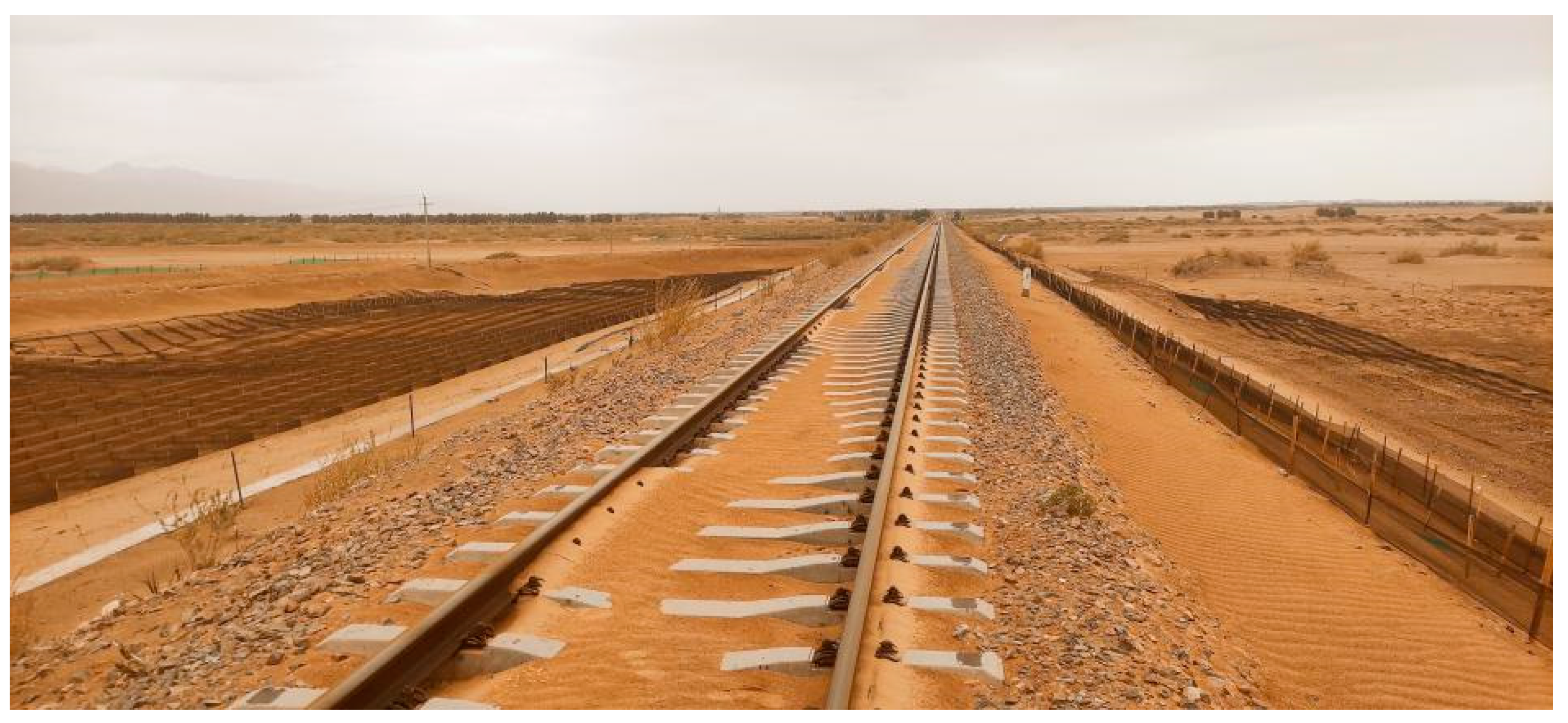
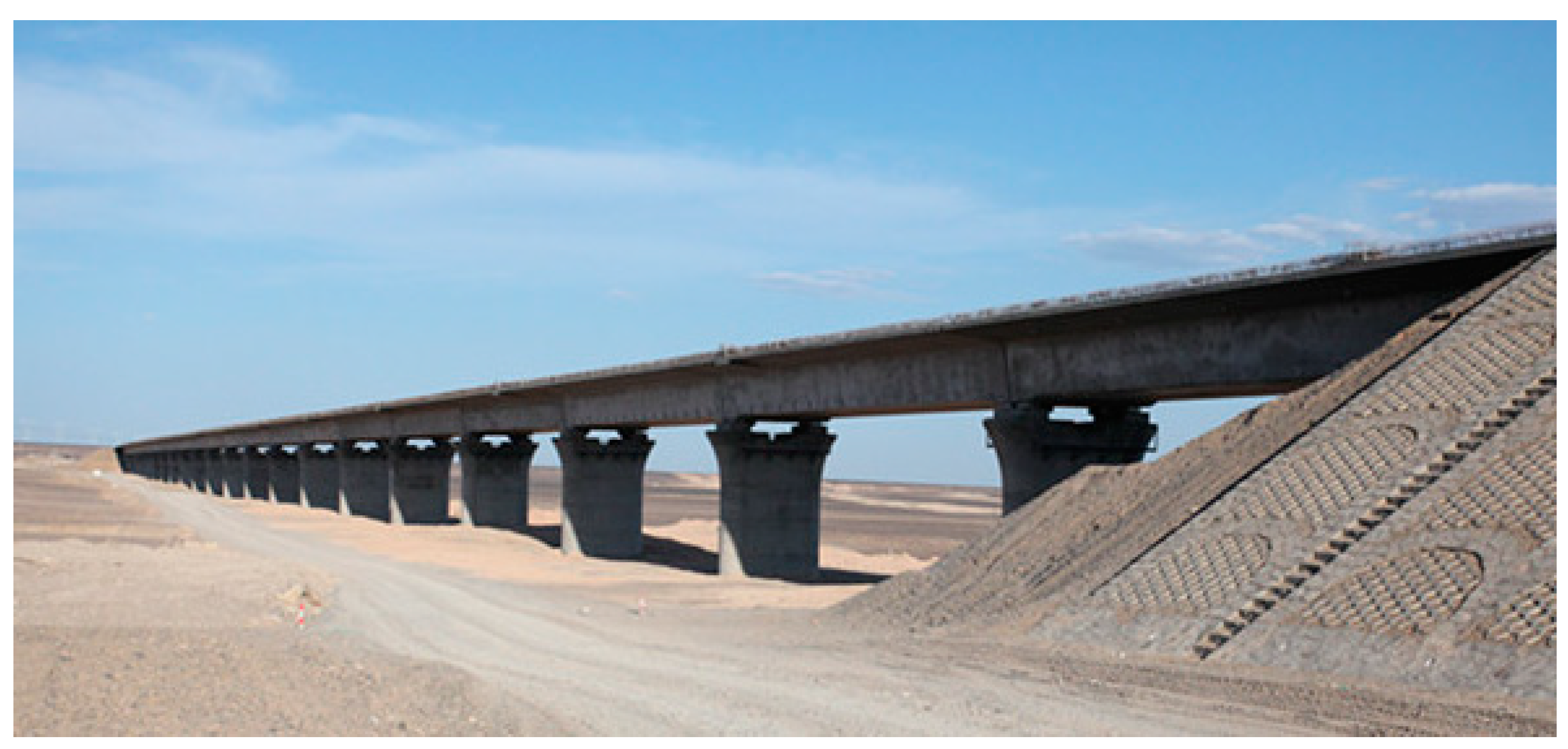
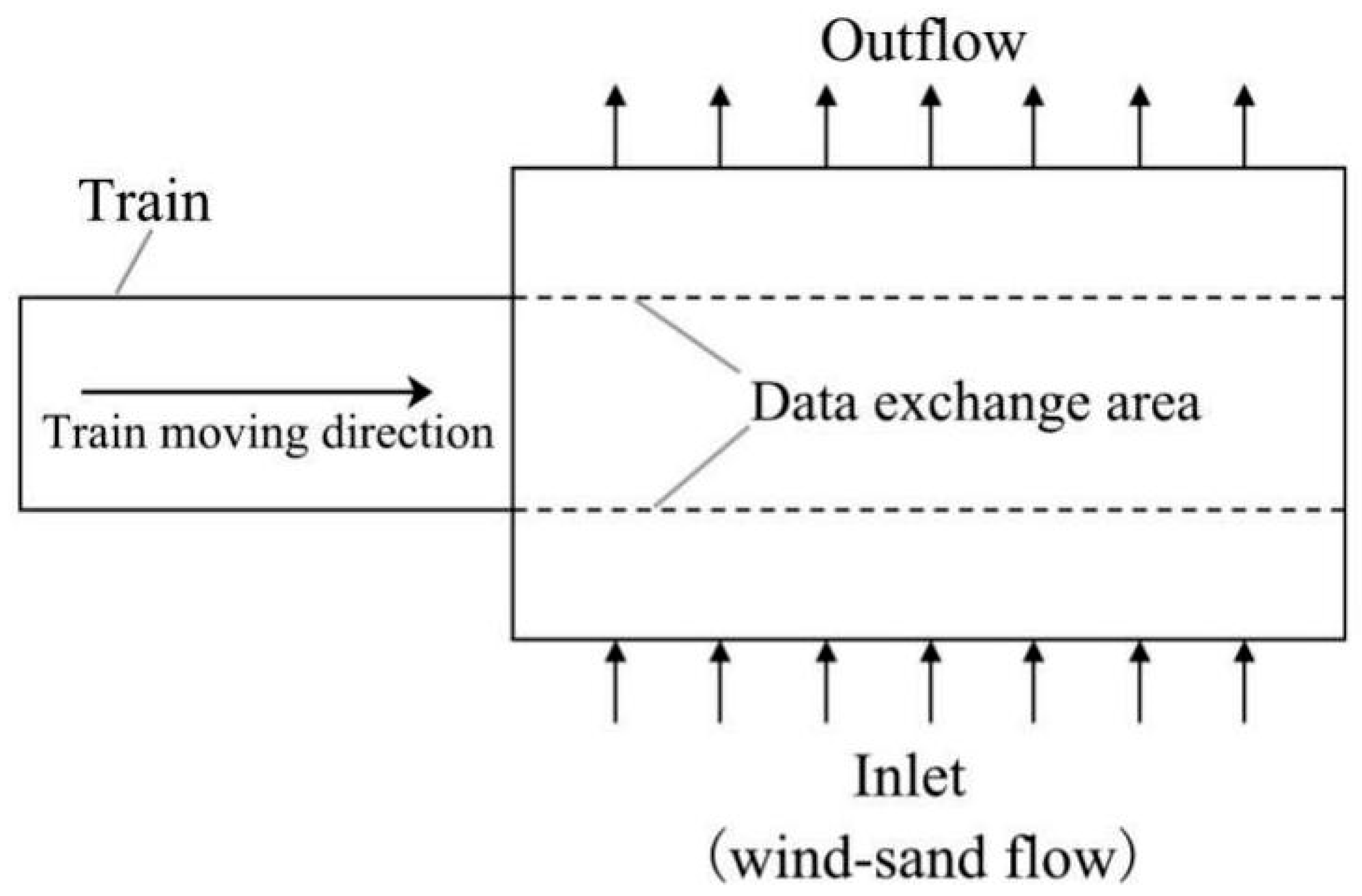

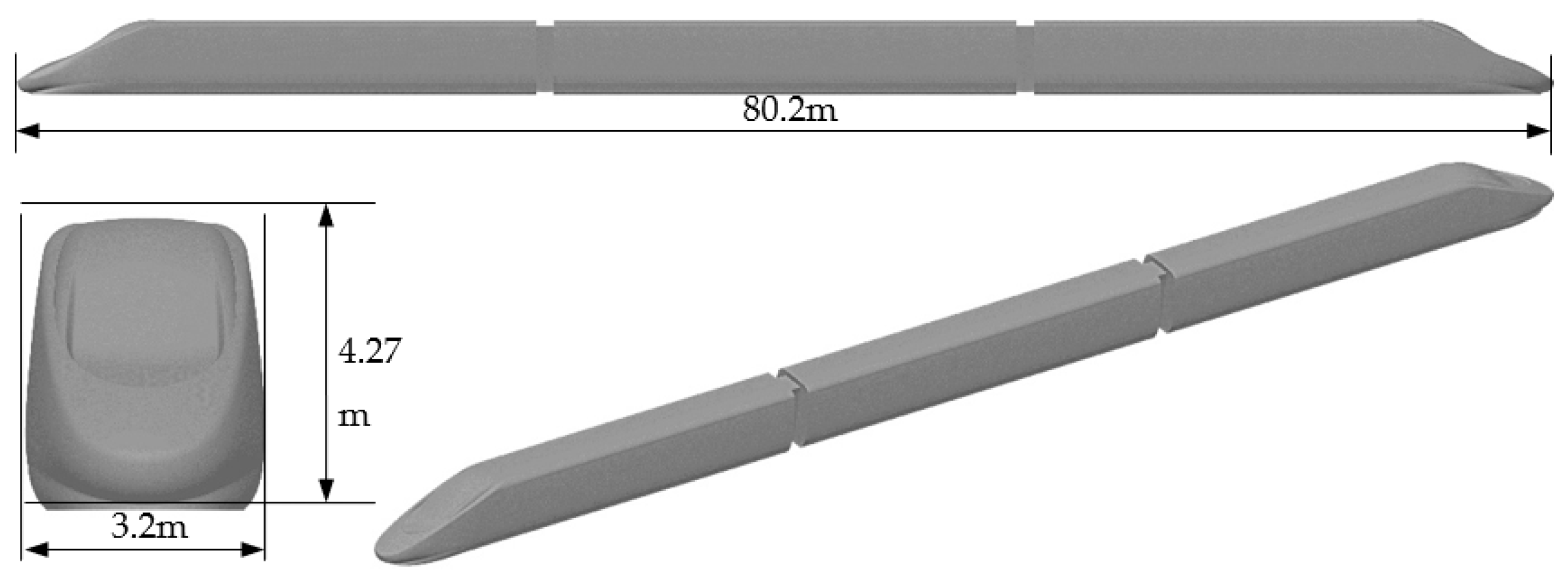


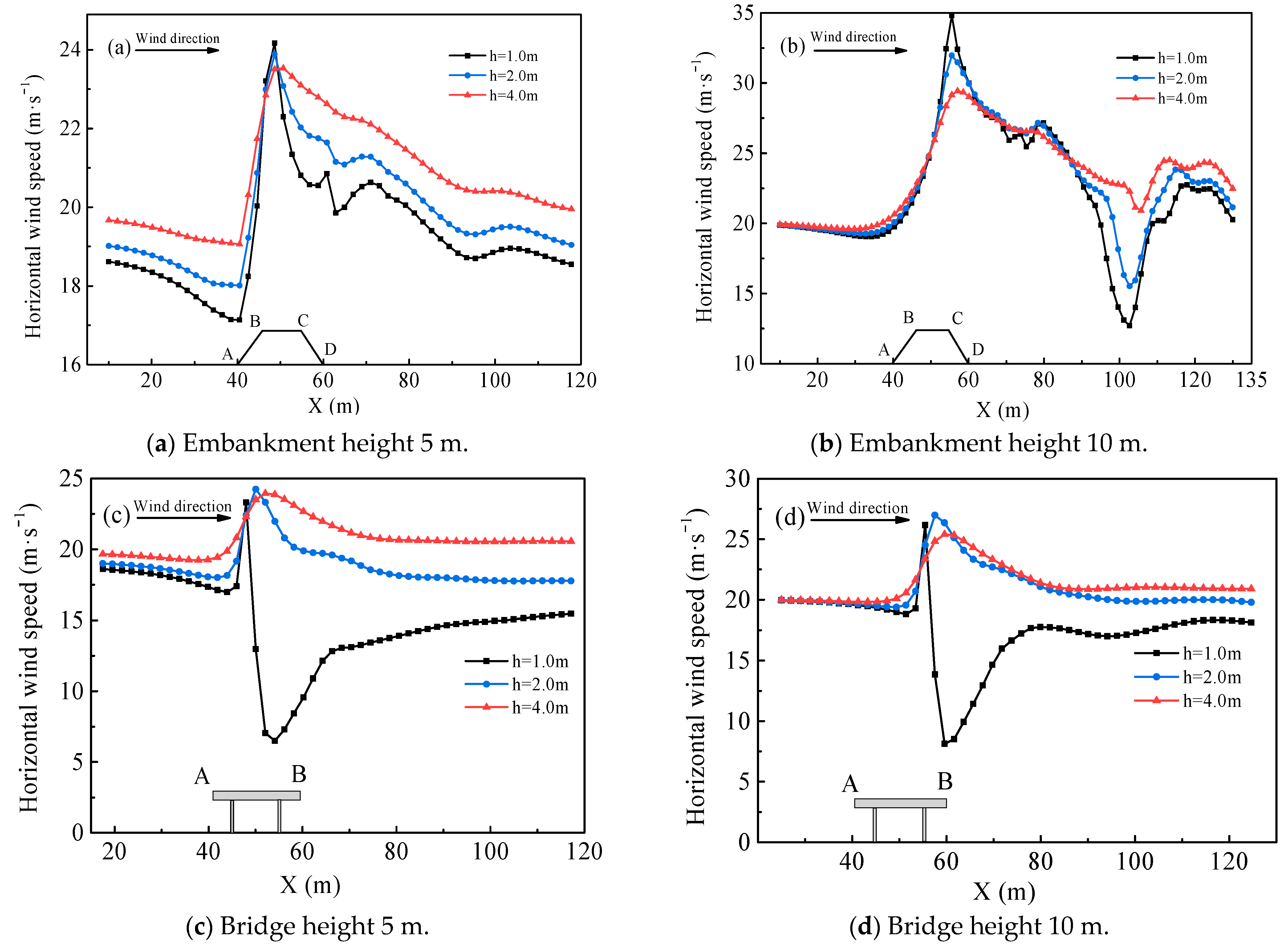
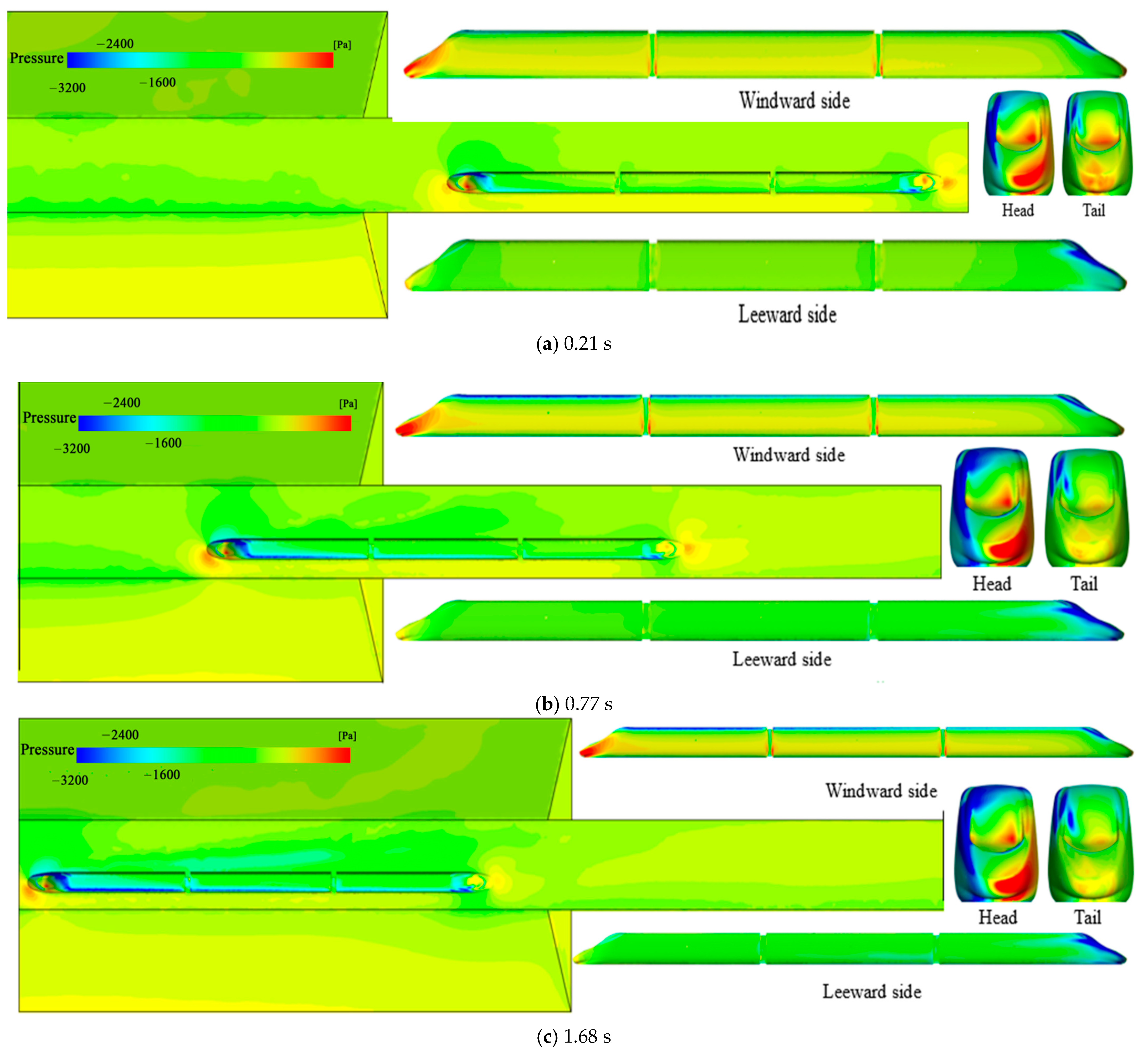

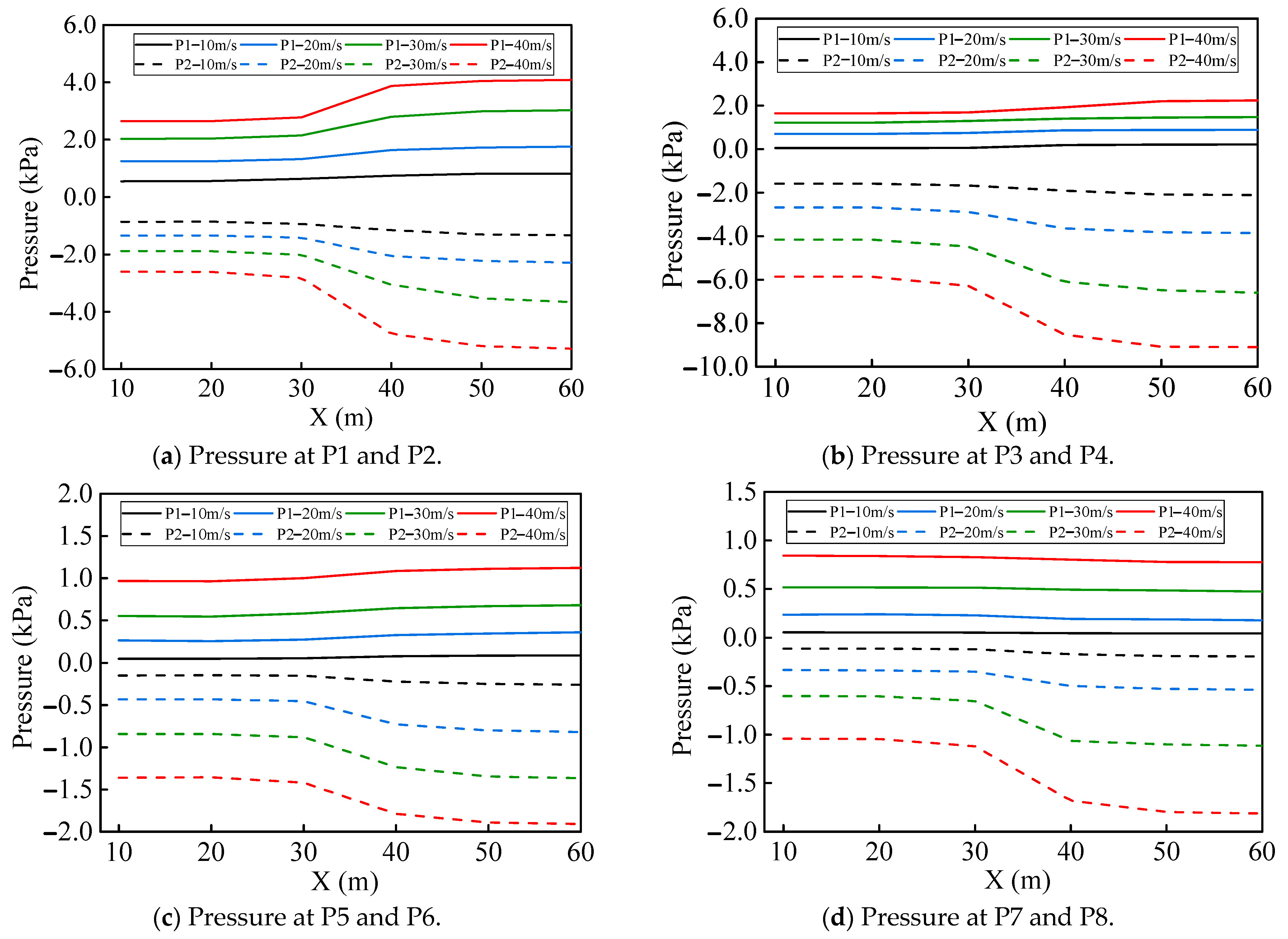

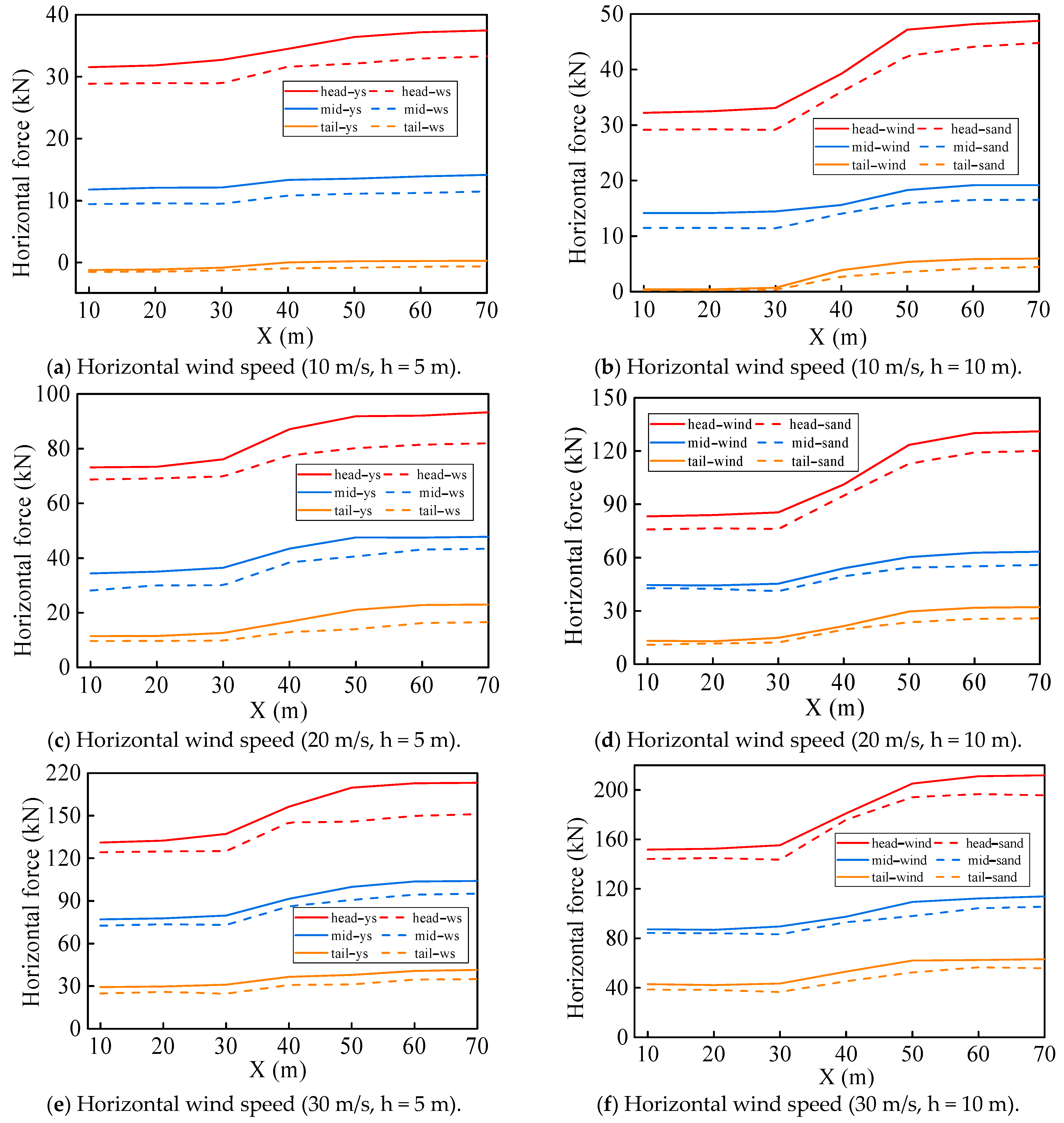
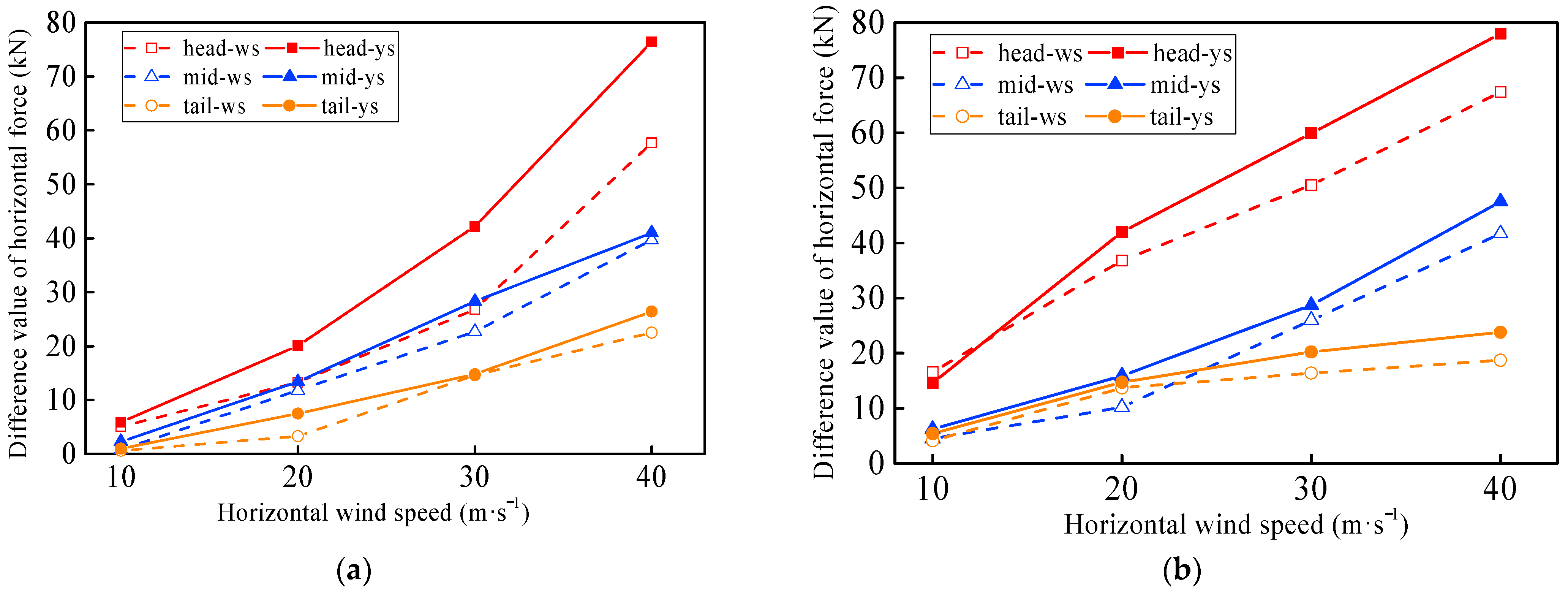
| Crosswind Speed/(m·s−1) | Sand Volume Fraction |
|---|---|
| 10 | 4.8 × 10−10 |
| 20 | 1.2 × 10−8 |
| 30 | 1.08 × 10−7 |
| 40 | 8.22 × 10−7 |
| 50 | 3.96 × 10−6 |
| Parameter | Value |
|---|---|
| Environment | No sand, wind–sand |
| Transition height | 5 m, 10 m |
| Crosswind speed | 10 m/s, 20 m/s, 30 m/s, 40 m/s |
| Train speed | 250 km/h |
| Sand density | 2650 kg/m3 |
| Sand diameter | 0.1 mm |
| Air/sand viscosity coefficient | 1.785/0.047 kg/(m·s) |
| Air density | 1.225 kg/m3 |
Disclaimer/Publisher’s Note: The statements, opinions and data contained in all publications are solely those of the individual author(s) and contributor(s) and not of MDPI and/or the editor(s). MDPI and/or the editor(s) disclaim responsibility for any injury to people or property resulting from any ideas, methods, instructions or products referred to in the content. |
© 2023 by the authors. Licensee MDPI, Basel, Switzerland. This article is an open access article distributed under the terms and conditions of the Creative Commons Attribution (CC BY) license (https://creativecommons.org/licenses/by/4.0/).
Share and Cite
Wang, P.; Huang, N.; Qi, Y.; Luo, W.; Xin, G. Investigating the Mutual Feedback between Wind–Sand Fields and a Running Train on the Bridge–Road Transition Section of a Railway. Sustainability 2023, 15, 14210. https://doi.org/10.3390/su151914210
Wang P, Huang N, Qi Y, Luo W, Xin G. Investigating the Mutual Feedback between Wind–Sand Fields and a Running Train on the Bridge–Road Transition Section of a Railway. Sustainability. 2023; 15(19):14210. https://doi.org/10.3390/su151914210
Chicago/Turabian StyleWang, Peng, Ning Huang, Yanlu Qi, Wenhao Luo, and Guowei Xin. 2023. "Investigating the Mutual Feedback between Wind–Sand Fields and a Running Train on the Bridge–Road Transition Section of a Railway" Sustainability 15, no. 19: 14210. https://doi.org/10.3390/su151914210





